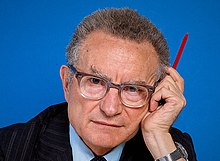Samuelson, Paul

Bio: (1915-2009) American economist. Paul Samuelson did his undergraduate studies at the University of Chicago and got his Ph.D. from Harvard. In 1940 he became an assistant professor of economics at Massachusetts Institute of Technology (MIT) and stayed there until his retirement in 1986. 1961 Samuelson served as President of the American Economic Association and in 1970 he was awarded the Nobel Memorial Prize in Economic Sciences. He served as an economic advisor in the administrations of US Presidents John Kennedy and Lyndon Johnson.
Samuelson made profound contributions to economic theory introducing mathematical methods and theoretical rigor. His textbook Economics (1947a), which had many updated editions served as an introductory textbook for students of economics for decades. It made economics more accessible to students by using clear language and real-world examples, and it firmly established Samuelson as a prolific and influential textbook author. His ability to convey complex economic concepts to a broad audience made him a revered figure in both academic and public circles.
In the same year he published his textbook Samuelson published his most important theoretical treatise in economics - Foundations of Economic Analysis (1947b). This book was seminal for the integration of mathematics into economics. Prior to this work, economics was often seen as a more qualitative and descriptive discipline. However, Foundations of Economic Analysis changed this perception by demonstrating the potential of mathematical tools to enhance economic understanding. With its mathematical treatment of economic concepts, this book laid the groundwork for modern economic theory, providing a framework that facilitated precise analysis and modeling of economic phenomena.
Perhaps Samuelson's most famous contribution to economics is the development of the neoclassical synthesis. In the early 20th century, there was a significant divide between Keynesian economics, which focused on aggregate demand and macroeconomic issues, and classical economics, which emphasized microeconomic principles and the importance of individual behavior. Samuelson bridged this gap by showing that, under certain assumptions, the Keynesian and classical models could be reconciled. This synthesis formed the basis of modern macroeconomics and helped economists better understand how macro-level phenomena are connected to micro-level behavior.
Beyond his macroeconomic theory, his greatest theoretical contribution were his theories on consumer choice, international trade, and public goods. He stated that observed consumer spending could expose consumer preferences that can reveal the utility consumers receive from different goods. He called this concept “revealed preference”. This theory demonstrated how individual choices could reveal underlying preferences and, consequently, how consumer behavior could be modeled mathematically. In this way, economists can test assumptions about consumer behavior. Samuelson argued that consumer preferences are consistent and transitive. This insight not only advanced microeconomic theory but also had practical implications for market analysis, consumer behavior prediction, and welfare economics.
His international trade theory examined the economic consequences of both free trade and protectionism. He stated that free trade between countries will lead to equalization of workers’ wages, a concept he called the “factor price equalization theorem. On the other hand, protections and tariffs will benefit capitalists in capital-intensive industries and will benefit skilled workers in those industries that depend on that kind of work. Samuelson was a vocal supporter of free trade and international cooperation, which he believed were essential for global economic stability and growth. His contributions to trade theory provided insights into the benefits of specialization and the gains from trade.
Samuelson's influence extended to policy as well. Samuelson, since adopting a middle position between Keynesian economics and classical economics, insisted that both monetary and fiscal policies had to be employed in order to expand and stabilize the US economy. Samuelson also adopted a middle position regarding fiscal policy, as he argued for both tax cuts and expansion of government programs.
In the article “Analytical Aspects of Anti-Inflation Policy” (1960) Samuelson and Robert Solow introduced the Phillips Curve relationship, named after British economist A.W. Phillips. The Phillips Curve states that increases in wages are inversely related to the unemployment rate. Samuleson’s theory of public goods (goods that can be used by everyone and which don’t follow zero-sum game rules) contributed to the development of public policy approaches aimed at addressing market failures and promoting social welfare.
Fields of research
Capitalism Consumerism Economy Industry International Relations Market Science Social PolicyTheoretical approaches
Neoclassical School (Economics)Main works
“A Note on the Pure Theory of Consumer’s Behavior”, in Economica (1938);
“Interactions between the Multiplier Analysis and the Principle of Acceleration”, in Review of Economics and Statistics (1939a);
“A Synthesis of the Principle of Acceleration and the Multiplier”, in Journal of Political Economy (1939b);
“Protection and Real Wages”, in Review of Economic Studies (1941);
Economics (1947a);
Foundations of Economic Analysis (1947b);
“International Trade and Equalisation of Factor Prices”, in Economic Journal (1948);
Linear Programming and Economic Analysis (1958)
“Analytical Aspects of Anti-Inflation Policy”, in American Economic Review (1960);
“Problems of Methodology—Discussion”, in American Economic Review (1963);
The Collected Scientific Papers of Paul A. Samuelson, 5 vols. (1966–77).

